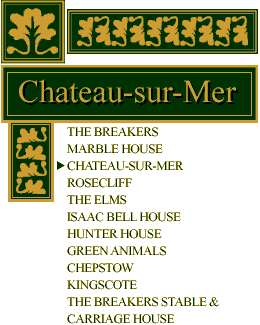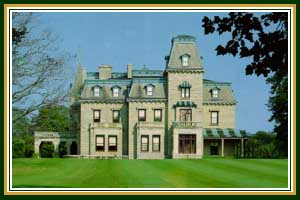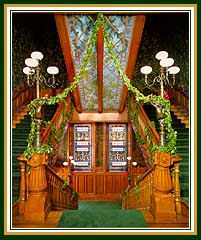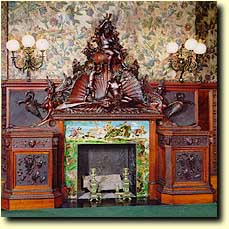

Bellevue Avenue, Newport, RI
Chateau-sur-Mer is a landmark of the High Victorian Age in America, being one of the finest examples of Victorian architecture. The ornate mansion was the most palatial residence in Newport from its construction in 1852 until the appearance of the Vanderbilt houses in the 1890's. Chateau-sur-Mer was the scene for memorable entertainments hosted by the Wetmore family, from the "Fete Champetre", an elaborate country picnic, for over two thousand guests and 3 orchestras on its grounds held in 1857 to the debutante ball for Miss Edith Wetmore in 1889. It was said that then President of the United States was also invited, but at the last minute was unable to attend.
Chateau-sur-Mer, with property extending to the sea, was built and modeled after a French chateau -- hence its name, "Castle by the Sea" between 1851 and 1852 for the China trade merchant William Shepard Wetmore. Mr. Wetmore died in 1862, leaving the bulk of his fortune from the China Trade to his son, George Peabody Wetmore, and a generous allowance for his daughter, Annie Derby Wetmore. George married Edith Keteltas in 1869. Although the mansion was luxurious and unusually spacious for its day, the structure was enlarged in 1872. During the 1870's, the young couple departed on an extended sojourn in Europe, engaging the architect Richard Morris Hunt to remodel and redecorate the house, including renovation of the Marble Hall. In 1897, Ogden Codman was commissioned to decorate the Green Salon, and, in the period of 1915 to 1918, the firm of Olmsted Brothers were engaged to make improvements to the grounds.
As a result of these successive decorating and remodeling schemes by the Wetmores, Chateau-sur-Mer displays most of the major design trends of the last half of the 19th century. The Gold Room (1854) by Leon Marcotte, and the Renaissance Revival style Dining Room and the huge granite building's Library of the 1870's by the Florentine sculptor Luigi Frullini, decorated with leather and lavishly carved walnut, exhibits the work of leading 19th century designers. Light streams into the galleried, 45-foot-high, three-story central hall through a stained-glass skylight -- also by Fullini, who also created the intricate woodwork. The grand staircase is illuminated by stained-glass windows and accented with canvas painted to resemble tapestry. The family bedrooms are important examples of English Aesthetic style interiors with wallpapers by Arts and Crafts designers such as William Morris and William Burges. Other notable features include a Turkish sitting room, and the French-style ballroom with sliding mirrored doors. The grounds feature specimen trees, such as weeping and copper beeches, a Chinese "moongate" in the south wall, and a colonial revival style garden house.
George Peabody Wetmore had a distinguished political career as Governor of Rhode Island and as a United States Senator. He died in 1921 and his wife in 1927. They were survived by their two daughters, the Misses Edith and Maude, who never married. Miss Edith died in 1966. The Preservation Society acquired the house in 1969.

